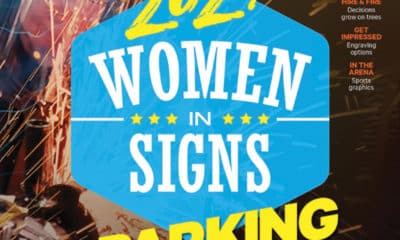LEDs + Lighting
The 11th Annual Lighting Survey: Excerpts
LEDs nearly overtake fluorescents, and white LEDs dominate.
Published
14 years agoon

The news is not that the average respondent to this year’s Lighting Survey suffered a sales-volume decline of 17.4% in 2009, compared to 2008. Such was expected, even though it was only the second time sales had dropped (on the heels of the overall 7.5% decline from 2007 to 2008) in this survey.
Most interesting, and unanticipated, are the results in Table 4, where fluorescent lighting, the undisputed choice for interior-sign illumination since 2004, now faces a serious challenge from LEDs. This represents the highest level of LED usage (and lowest level of fluorescent use) this survey has seen.
The results of this survey were obtained by posting the questionnaire on www.signweb.com. The sampling is rather small, so the following results should be considered a snapshot, and not necessarily indicative of the sign industry at large.
One note: We received a reply from a $240 million company for which electric signs represent 5% of its sales. Therefore, the sales-per-respondent figure in Table 1 is artificially high, and the corresponding electric-sign sales percentage is artificially low. Combined, the two figures then probably produce an accurate net of electric-sign sales.
If we disregard that response, respondents’ average sales volume falls to $1,702,480, which would be the lowest figure since 2003. Similarly, this would drop total electric-sign sales to $29,175,424 and the average electric-sign sales per company to $572,067, both of which would be the lowest figures this study has seen by a significant margin.
Note: Whenever we say “this year,” it means 2009, and “last year” refers to 2008.
Here are some of the significant findings:
• Fluorescent lighting, the undisputed leader in interior-sign illumination for the past four years, barely edged out LEDs in 2009 as the most popular light source. (Table 4). The LED percentage (31.8%) is its highest ever. Conversely, fluorescent’s 32.5% is by far its lowest ever.
• LEDs continue to steal marketshare from neon, and now nearly double the use of neon (Table 10).
• Nearly two-thirds of the respondents reported declining sales from 2008 to 2009, by an average of 34% (Table 2). However, 13 respondents reported an average sales-volume increase of nearly 15%.
• Use of neon indoors (29.2%) is the highest percentage this study has seen (Table 6). Although channel letters still account for nearly two-thirds of all neon usage, the 62.6% ties for the lowest percentage ever. Conversely, use of neon for art/sculpture (7.6%) is at an all-time high. While “new” neon has always accounted for at least double the sales of repaired neon, this year, the sales are neck and neck.
• Use of LEDs for border lighting (6.6%) is the lowest yet in five years of asking the question (Table 8).
The respondents
Even though our sampling (58) is relatively small, it’s still more than what we received in 2007 and 2005 (2006 and 2004 results, respectively). Fortunately, the first three sales-volume categories are equally represented, so the mix better justifies any extrapolations. Also, even though we
had more than twice as many responses last year, the number who provided their sales-volume information is only three less than last year (Table 1), when there were 67 “unknowns.”
As noted above, the deletion of the $240 million company’s responses would significantly impact the totals. Likewise, if we recalculate the percentage of overall sales devoted to electric signs, it rises to 42.9%, which would still be the smallest percentage this study has seen by a sizeable margin. As already stated, the recalculated average electric-sign sales per company is also a new low.
And yes, most respondents had a bad 2009. Perhaps the aggregate 17.4% loss in total sales may even be understated (Table 2). We’re nervously awaiting the results for the Electric SOI Report that will appear in the July issue.
Here, companies that suffered declining 2009 sales outnumbered those whose sales increased by nearly a 3:1 margin. And the average percentage of decline (33.9%) more than doubled the average rate of increase (14.8%). Each represents an historical extreme for this study: the highest average percentage of decline and the lowest average percentage of increase.
For every sales-volume category, however, the rate of decline in electric-sign sales was less than the percentage of overall sales’ decline. So, essentially, non-electric-sign sales were hit harder than electric-sign sales for all sales-volume categories.
Illumination
Table 4 has been consolidated from prior years. Previously, we had separate columns for “incandescent,” “HID” and “fiberoptics.” However, because none of these typically captured even 4% of the overall sign-illumination market, this year we combined those three with “other,” which we also did for the results for all prior years. So, automatically, “other” will be higher, but that doesn’t affect comparisons with prior years, which are similarly higher.
Most interesting is LEDs’ proximity to fluorescents for sign illumination. LEDs didn’t increase dramatically; the 31.8% is only 1.6% higher than the 30.2% from two years ago. However, fluorescents plunged from their previous low of 36.7% (2002) to 32.5%. The difference is countered by a huge increase in “other,” which grew from 10.6% to 16.1%. And column consolidation didn’t cause that change, because prior results also were recalculated.
Neon nuances
Table 6 documents numerous aspects of neon’s current usage. Outsourced neon (67.2%) doubles the amount produced inhouse (32.8%). Even though the percentage outsourced is the lowest in the past three years, it’s much higher than any of the percentages in the first five years of this study.
Also, as noted in the bulleted comments, the percentage of neon being used indoors (29.2%) is at an all-time high.
Although channel letters continue to dominate as the primary use of neon (62.6%), that percentage ties for the lowest percentage yet. The 5.2% for cabinet signs also represents a new low. These have been countered by new highs for art/sculpture (7.6%) and “other” (8.9%).
Clearly, this suggests the double whammy of a struggling economy and the loss of marketshare to LEDs has compelled tubebenders to more aggressively seek new or peripheral markets.
Finally, Table 6 also examines the ratio of new neon versus sales for neon repair. By far, the 51.9% for new neon is an all-time low, countered by the 48.1% for neon repair that significantly represents a new high. We can only guess this reflects a relatively stable amount of neon repair, but a sharp decline in the amount of new neon being produced.
Table 8 differs from this same table in prior years as “channel letters” and “reverse channel letters” have been combined into the former, as have the totals for prior years. The results lean toward greater use of LEDs indoors. The 20.8% nearly matches the 21.8% high from two years ago.
The use of LEDs for border tubing (6.6%) is the lowest in the five years of asking this question. Conversely, the enigmatic “other” category (11.4%) is more than double any other year’s result, which suggests our same assessment of the heightened “other” percentage in neon’s Table 6 results.
Neon vs. LEDs
The final three tables scrutinize the choice between neon and LEDs. The gap continues to widen, as LEDs (64.3%) will probably soon be used twice as much as neon (35.7%, Table 10). Only five years ago, neon usage (76.5%) more than tripled LED (23.5%) usage, but LEDs surpassed neon two years ago and haven’t looked back.
Green remains neon’s strongest color, as 43.2% still prefer it to green LEDs (56.8%). In ubiquitous white, LEDs are preferred over neon by exactly a 3:1 ratio.
To order a copy of the complete 11th Annual Lighting Survey in the May 2010 issue of Signs of the Times, click here.
SPONSORED VIDEO
Introducing the Sign Industry Podcast
The Sign Industry Podcast is a platform for every sign person out there — from the old-timers who bent neon and hand-lettered boats to those venturing into new technologies — we want to get their stories out for everyone to hear. Come join us and listen to stories, learn tricks or techniques, and get insights of what’s to come. We are the world’s second oldest profession. The folks who started the world’s oldest profession needed a sign.
You may like
Advertisement
Subscribe

Magazine
Get the most important news
and business ideas from Signsofthetimes Magazine.
Advertisement
Most Popular
-

 News7 days ago
News7 days agoWoman Found Living Inside Supermarket Sign
-

 Projects2 weeks ago
Projects2 weeks ago4 of the Most Fun Sign Projects in Years
-

 Real Deal7 days ago
Real Deal7 days agoA Family Sign Company Foists Their Youngest Upon the Business
-

 How To2 weeks ago
How To2 weeks agoMaking the Grade with ADA Signs
-

 Photo Gallery5 days ago
Photo Gallery5 days ago17 Sneak Peeks at the American Sign Museum Main Street Expansion
-

 Editor's Note1 week ago
Editor's Note1 week agoThe Joy of Working
-

 Tip Sheet5 days ago
Tip Sheet5 days agoReward Installers for Leads and Organization — Two of May’s Sign Tips
-

 News2 weeks ago
News2 weeks agoSign Company Owner Meets Travis Kelce















